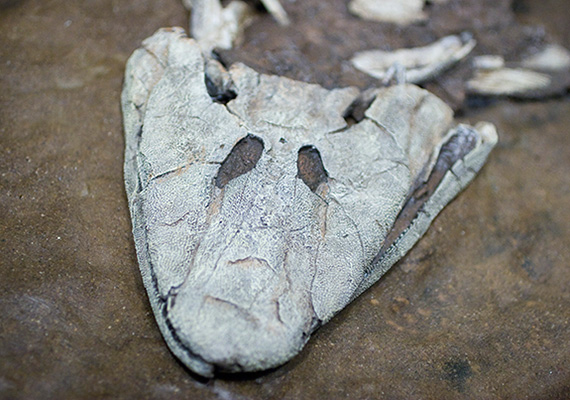
The late Farish Jenkins (pictured), who was the Alexander Agassiz Professor of Zoology and longtime curator of vertebrate paleontology at Harvard’s Museum of Comparative Zoology, was part of the team that has found evidence that the evolution of hind limbs in tetrapods began in the oceans, earlier than scientists initially believed.
File photo by Justin Ide/Harvard Staff Photographer
Fin to limb
Fossil research yields key clues to ocean-to-land evolution
Scientists may be close to unraveling one of the longest-standing questions in evolutionary biology — whether limbs, particularly hind limbs, evolved before or after early vertebrates left the oceans for life on land.
Following an examination of pelves and a partial pelvic fin of Tiktaalik roseae, a 375-million-year-old transitional species between fish and the first legged vertebrates, a team of researchers found evidence that early hind legs began as enhanced hind fins, suggesting that their evolution began in the oceans, earlier than scientists initially believed. The late Farish Jenkins, who was the Alexander Agassiz Professor of Zoology and longtime curator of vertebrate paleontology at Harvard’s Museum of Comparative Zoology, was part of the team. The study is described in a Jan. 13 paper in the Proceedings of the National Academy of Sciences.
Discovered in 2004 by Jenkins, Professor Neil Shubin of the University of Chicago, and Edward Daeschler, associate curator of vertebrate zoology at the Academy of Natural Sciences of Drexel University, Tiktaalik roseae represents the best-known transitional species between fish and land-dwelling tetrapods.

“There has been a great deal written about how limbs evolved, and in what sequence — did forelimbs evolve first, and then hind limbs, or vice versa — and the findings of this paper help resolve some of those competing hypotheses,” said James Hanken, the Alexander Agassiz Professor of Zoology and director of the Museum of Comparative Zoology. “It appears that hind-limb dominance had begun to evolve in these aquatic creatures, so Tiktaalik was poised to give rise to tetrapods, because it had already started to evolve some of the features that facilitate life on land.”
“Previous theories, based on the best available data, propose that a shift occurred from ‘front-wheel drive’ locomotion in fish to more of a ‘four-wheel drive’ in tetrapods,” said Shubin. “But it looks like this shift actually began to happen in fish, not in limbed animals.”
A lobe-finned fish with a broad flat head and sharp teeth, Tiktaalik looked like a cross between a fish and a crocodile, growing to a length of 9 feet as it hunted in shallow freshwater environments. It had gills, scales, and fins, but also tetrapodlike features such as a mobile neck, robust ribcage, and primitive lungs. In particular, its large forefins had shoulders, elbows, and partial wrists, which allowed it to support itself on land.
Until recently the only Tiktaalik specimens that had been described included just the front portion of the animal.
As researchers investigated additional blocks recovered from their original and subsequent expeditions to the dig site in northern Canada, they discovered the rear portion of Tiktaalik, which contained the pelves as well as partial pelvic fin material. The fossils included the complete pelvis of the original ‘type’ specimen, making possible a direct comparison of the front and rear appendages of a single animal.
Almost immediately, scientists were struck by the pelvis, which was comparable to those of some early tetrapods. The Tiktaalik pelvic girdle was nearly identical in size to the shoulder girdle, a tetrapodlike characteristic. It possessed a prominent ball-and-socket hip joint, which connected to a highly mobile femur that could extend beneath the body. Crests on the hip for muscle attachment indicated strength and advanced fin function. Although no femur bone was found, pelvic fin material, including long fin rays, indicated the hind fin was at least as long and as complex as its forefin.
“This is an amazing pelvis, particularly the hip socket, which is very different from anything that we knew of in the lineage leading up to limbed vertebrates,” Daeschler said. “Tiktaalik was a combination of primitive and advanced features. Here, not only were the features distinct, but they suggest an advanced function. They appear to have used the fin in a way that’s more suggestive of the way a limb is used.”
Tiktaalik pelves were still clearly fishlike, with primitive features such as an undivided skeletal configuration, as opposed to the three-part pelvic girdle of early tetrapods. However, the expanded size, mobility, and robustness of the pelvic girdle, hip joint, and fin of Tiktaalik made a wide range of motor behaviors possible.
“It’s reasonable to suppose with those big fin rays that Tiktaalik used its hind fins to swim like a paddle,” Shubin said. “But it’s possible it could walk with them as well. African lungfish living today have similarly large pelves, and we showed in 2011 that they walk underwater on the bottom. Regardless of the gait Tiktaalik used, it’s clear that the emphasis on hind appendages and pelvic-propelled locomotion is a trend that began in fish, and was later exaggerated during the origin of tetrapods.”
In addition to shedding new light on the development of tetrapods, the paper is noteworthy as one of Jenkins’ final academic works, Hanken said.
“This may not be the last paper that will ever be published with his name, but it certainly is one of them,” he said of the scholar, who died in 2012. “Farish made a number of very important discoveries in the course of his career, and Tiktaalik was one of them. This is a very important paper, and it’s wonderful to see his work being completed.”
Visitors to the Harvard Museum of Natural History can see a model of Tiktaalik roseae as part of its Evolution gallery, and learn more about ongoing evolution research at Harvard, from exciting new discoveries about human origins to surprising insights from new genetic and developmental studies on Darwin’s finches.





